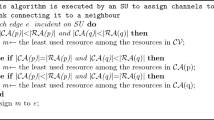Abstract
The increasing demands for wireless communication in all fields of life indicate a promising commercial potential. Cognitive radio (CR) is introduced as the radio that can replace the present smart phones in the future. Cooperative spectrum sensing is considered as an important step toward coexistence of CRs with primary users. Spectrum sensing needs to be reliable at anywhere at any time. In this paper, we put forward a scenario where cooperative spectrum sensing may not be reliable due to the specialty of the region. We also propose a fusion rule to make a reliable decision fusion at those regions. We have analyzed the performance of this fusion rule under Rayleigh fading channel and shadowing. Two separate simulation setups have been used to model these scenarios. Performance of the proposed fusion rule is compared with other fusion rules in the literature. The feature of adjustable weights according to the position of the CRs has enabled this fusion rule to perform better in the scenarios considered. With the feature of adaptability, this rule can work well in all scenarios related to cooperative spectrum sensing.







Similar content being viewed by others
References
K. Arshad, M.A. Imran, K. Moessner, Collaborative spectrum sensing optimisation algorithms for cognitive radio networks. Int. J. Digit. Multimed. Broadcast. 2010, 1–20 (2010)
Z. Chao, C. Chigan, in Licensed Receiver Detection and Authentication in Simplex Licensed Networks. IEEE GLOBECOM Workshops (GC Wkshps), pp. 924–929 (2011)
F.F. Digham, M.-S. Alouini, M.K. Simon, On the energy detection of unknown signals over fading channels. IEEE Trans. Commun. 55(1), 21–24 (2007)
W. Ejaz, N. ul Hasan, S. Lee, H.S. Kim, Intelligent spectrum sensing scheme for cognitive radio networks. J. Wirel Commun. Netw. 2013, 26 (2013). doi:10.1186/1687-1499-2013-26
A. Goldsmith, in Wireless Communications, chap. 2 (Cambridge University Press, Cambridge, 2005), p. 53
W. Han, J. Li, Z. Tian, Y. Zhang, Efficient cooperative spectrum sensing with minimum overhead in cognitive radio. IEEE Trans. Wirel. Commun. 9(10), 3006–3010 (2010)
T.J. Harrold, P.C. Faris, M.A. Beach, in Distributed Spectrum Detection Algorithms For Cognitive Radio. IET Seminar on Cognitive Radio and Software Defined Radio Technologies and Techniques , pp. 1–5 (2008)
M. Hayar, R. Knopp, R. Pacalet, in Cognitive Radio Research and Implementation Challenges. Asilomar Conference on Signals, Systems and Computers, pp. 782–786 (2007)
T. Hoang, Y.C. Liang, Y.H. Zeng, Adaptive joint scheduling of spectrum sensing and data transmission in cognitive radio networks. IEEE Trans. Commun. 58(1), 235–246 (2010)
J. Jacob, A. Panicker, J. Mathew, A.P. Vinod, in Exploration of a Distributed Approach for Simulating Spectrum Sensing in Cognitive Radio. Proceedings of the International Conference on Communication and Signal Processing (ICCSP-2011), Calicut, India, pp. 250–254 (2011)
X. Kang, Y.-C. Liang, A. Nallanathan, in Optimal Power Allocation for Fading Channels in Cognitive Radio Networks Under Transmit and Interference Power Constraints. Proceedings of the IEEE International Conference on Communications (ICC), Beijing, China, pp. 3568–3572 (2008)
J. Ma, G. Zhao, Y. Li, Soft combination and detection for cooperative spectrum sensing in cognitive radio networks. IEEE Trans. Wirel. Commun. 7(11), 4502–4507 (2008)
M. Matinmikko, T. Rauma, M. Mustonen, I. Harjula, H. Sarvanko, A. Mammela, Application of fuzzy logic to cognitive radio systems. IEICE Trans. Commun. E92–B(12), 3572–3580 (2009)
T.S. Rappaport, Mobile Radio Propagation: Large-Scale Path Loss, Wireless Communications: Principles and Practice (Prentice Hall, Upper Saddle River, 1999)
E.M. Taghavi, B. Abolhassani, Two step secure spectrum sensing algorithm using fuzzy logic for cognitive radio networks. Int. J. Commun. Netw. Syst. Sci. 4(8), 507–513 (2011)
T. Yucek, H. Arslan, A survey of spectrum sensing algorithms for cognitive radio applications. IEEE Commun. Surv. Tutor. 11(1), 116–130 (2009)
L. Zhang, Y. Xin, Y.-C. Liang, Weighted sum rate optimization for cognitve radio MIMO broadcast channels. IEEE Trans. Wirel. Commun. 8(6), 2950–2959 (2009)
Author information
Authors and Affiliations
Corresponding author
Rights and permissions
About this article
Cite this article
Jacob, J., Jose, B.R. & Mathew, J. Fusion Rule for Cooperative Spectrum Sensing in Cognitive Radio. Circuits Syst Signal Process 35, 3418–3430 (2016). https://doi.org/10.1007/s00034-015-0208-0
Received:
Revised:
Accepted:
Published:
Issue Date:
DOI: https://doi.org/10.1007/s00034-015-0208-0




